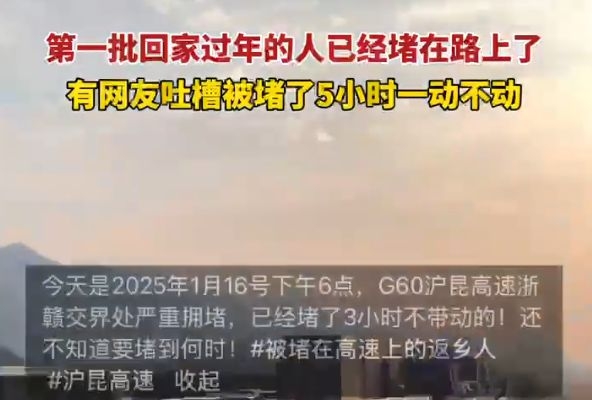The Great Return Home wave on the mainland has started, but the news of “the first group of people returning home for the Chinese New Year is already causing traffic jams” has become a hot topic.
On January 16th, a netizen revealed that they were stuck on the Shanghai-Kunming Expressway for 5 hours without moving.
Another netizen complained: After traffic jams in Zhejiang, then Jiangxi, and after Jiangxi, Hunan is still jammed…
Videos posted by netizens show many people standing next to their cars, refreshing news on their phones, chatting; some drivers even walked along the roadside.
According to media reports, due to the expansion and construction on a section of the Shanghai-Kunming Expressway in Jiangxi, traffic can only flow in one direction from east to west on two lanes, causing jams during the return home rush. People heading back to Yunnan, Guizhou, Sichuan, Chongqing, Hunan, and Hubei are advised to take alternative routes via the Quzhou and Jiangxi sections of the Shanghai-Kunming Expressway.
“The first group of people returning home for the Chinese New Year is already causing traffic jams” trended on January 17th, sparking discussions among netizens.
A netizen from Henan, hamomila, said: “Don’t worry, no matter which batch is going home, they will all be stuck on the road, it’s always a jam sooner or later.”
Another netizen from Guangdong, 4695e12, said: “It would be great to have more trains available for returning home, the number of trains running now is too low…”
Blogger “Observing the World Affairs” stated that the traffic congestion is not only a time-consuming torment but also causes many drivers to feel frustrated. This kind of traffic jam is very exhausting. The Chinese New Year is an important moment for family reunions, and people who have worked hard all year for a chance to reunite with their loved ones at home for a few rare days of vacation.
With the Snake Year approaching, the so-called “largest population migration on earth” in China has begun on January 14, peak traffic is expected for 40 days. Authorities estimate that the volume of cross-regional personnel movement in 2025 will reach 9 billion person-times, and railway and civil aviation passenger traffic are expected to exceed 510 million person-times and 90 million person-times respectively, both reaching historical highs, with self-driving and high-speed rail being the main methods of returning home.
At Beijing Station, crowds of people with luggage are rushing back home, looking forward to reuniting with family.
According to reports by “The Paper,” the Guangzhou Railway Group operated an average of 2027 passenger trains before the Chinese New Year, an increase of 158.5 compared to last year. Ticket sales data shows that passenger flows are mainly concentrated in Guangzhou, Shenzhen, Dongguan, and other areas. The Guangzhou Railway Group increased its daily out-of-province passenger trains to 759.5 pairs to meet the demand for travels to Hunan, Guizhou, Sichuan, Chongqing, and Guangxi.
After the Chinese New Year, the average daily operation of passenger trains increased to 2048 pairs, an increase of 161.5 over last year. Passenger flows are concentrated in Changsha, Yueyang, Hengyang, Huaihua, and Zhangjiajie. The Guangzhou Railway Group operates an average of 217 out-of-province passenger trains to Guangdong and Shanghai in the direction of Hunan, an increase of 6 compared to last year.

